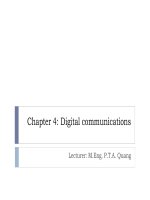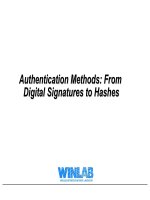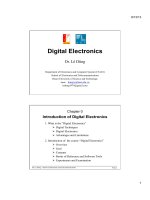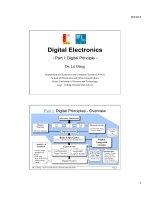Chapter+05+ digital+ signatures
Bạn đang xem bản rút gọn của tài liệu. Xem và tải ngay bản đầy đủ của tài liệu tại đây (251.08 KB, 17 trang )
Cryptography and Network Security
Chapter 5
Digital Signatures
Lectured by
Nguyễn Đức Thái
Outline
Digital Signatures
Digital Signature Algorithm and Standard
2
Digital Signatures
A digital signature is an authentication
mechanism that enables the creator of a
message to attach a code that acts as a
signature.
Typically the signature is formed by taking
the hash of the message and encrypting
the message with the creator’s private
key.
The signature guarantees the source and
integrity of the message.
The digital signature standard (DSS) is an
NIST standard that uses the secure hash
3
algorithm (SHA).
Digital Signature Model
4
Digital Signature Model
5
Attacks and Forgeries
attacks
•
•
•
•
•
key-only attack
known message attack
generic chosen message attack
directed chosen message attack
adaptive chosen message attack
break success levels
• total break
• selective forgery
• existential forgery
6
Digital Signature Requirements
must depend on the message signed
must use information unique to sender
• to prevent both forgery and denial
must be relatively easy to produce
must be relatively easy to recognize &
verify
be computationally infeasible to forge
• with new message for existing digital signature
• with fraudulent digital signature for given
message
be practical save digital signature in
storage
7
Direct Digital Signatures
involve only sender & receiver
assumed receiver has sender’s public-key
digital signature made by sender signing
entire message or hash with private-key
can encrypt using receivers public-key
important that sign first then encrypt
message & signature
security depends on sender’s private-key
8
Digital Signature Standard
(DSS)
US Govt approved signature scheme
designed by NIST & NSA in early 90's
published as FIPS-186 in 1991
revised in 1993, 1996 & then 2000
uses the SHA hash algorithm
DSS is the standard, DSA is the algorithm
FIPS 186-2 (2000) includes alternative RSA
& elliptic curve signature variants
DSA is digital signature only unlike RSA
is a public-key technique
9
DSS vs. RSA Signatures
10
Digital Signature Algorithm
(DSA)
creates a 320 bit signature
with 512-1024 bit security
smaller and faster than RSA
a digital signature scheme only
security depends on difficulty of computing
discrete logarithms
variant of ElGamal & Schnorr schemes
11
DSA Key Generation
have shared global public key values
(p,q,g):
• choose 160-bit prime number q
• choose a large prime p with 2L-1 < p < 2L
o where L= 512 to 1024 bits and is a multiple of 64
o such that q is a 160 bit prime divisor of (p-1)
• choose g = h(p-1)/q
o where 1
users choose private & compute public
key:
• choose random private key: x
12
DSA Signature Creation
to sign a message M the sender:
• generates a random signature key k, k
and never be reused
then computes signature pair:
r = (gk mod p)mod q
s = [k-1(H(M)+ xr)] mod q
sends signature (r,s) with message M
13
DSA Signature Verification
having received M & signature (r,s)
to verify a signature, recipient
computes:
w = s-1 mod q
u1= [H(M)w] mod q
u2= (rw) mod q
v = [(gu1 yu2) mod p] mod q
if v=r then signature is verified
see Appendix A for details of proof why
14
DSS Overview
15
Summary
We have discussed:
Digital Signatures
Digital Signature Algorithm and Standard
16
References
1. Cryptography and Network Security,
Principles and Practice, William Stallings,
Prentice Hall, Sixth Edition, 2013
17
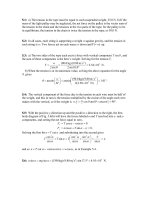
![Tài liệu [ Team LiB ] Using Digital Signatures pptx](https://media.store123doc.com/images/document/14/nu/fp/medium_fpp1390245651.jpg)




